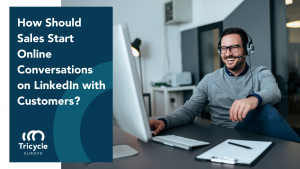The necessary digital transformation, catalyzed by the COVID-19 pandemic, has turned remote work from a privilege to the new normal. Under these new parameters, most sales conversations kick off in the digital space. Rather than solely being visible online, we must start online conversations on LinkedIn and engage with our leads. What are the benefits of this modern approach? We’ve identified five main reasons and listed them below.
1. Customers are having more online conversations on LinkedIn
The continuing COVID-19 pandemic has changed the sales landscape, and businesses are tapping into the potential of social networking spaces. The ripples of this shift are noticeable across industries and verticals, but experts explain that the changes are here to stay. A LinkedIn online presence is all but essential to be remembered in today’s business ecosystem–the next and most important piece in that equation is consistent engagement.
Due to social distancing limitations, sales professionals are forced to carry out early interactions and gain initial insights in the online space. First interactions aren’t happening at networking events, via email, or on the phone anymore. These online conversations are key to maintaining consistent communication and understanding people’s pain points, and today, this is happening on LinkedIn.
2. To nurture the customer through the buying cycle
The buyer’s journey is no longer a single funnel. In fact, there are multiple entry and exit points. It’s more demanding than ever for salespeople to track movements and ensure they’re engaging with information at the right level.
The internet age has given almost everyone easy access to endless information about products or services. Depending on what they already know, we want to frame this knowledge with the right touchpoints depending on where they are on the buyer’s journey.
3. LinkedIn online conversations generate trust
To be able to build long-term relationships with stakeholders, it is essential to place emphasis on personal, not canned, interactions. People appreciate when people remember things about them and listen to their pain points.
According to LinkedIn, over 62% of B2B buyers respond to salespeople that connect by sharing insights that are directly relevant to them. Providing value helps develop a solid and sustainable relationship, rather than throwing them a canned sales pitch. Personalize your message and always focus on their needs.
4. It helps you to establish yourself as a thought leader and industry expert
Fruitful online engagement helps you to position yourself as an expert within your industry. This includes regularly posting, sharing, liking, and commenting in the LinkedIn community as well as publishing blogs. Keep in mind that not all profiles have a blog-posting option but if yours happens to, take full advantage of this resource.
If you’re consistently staying engaged and engaging with others, this opens the door for people to approach you when they need answers on a specific topic. You’ll appear to be less of a salesperson and more of a trusted source.
5. Identify key decision–makers
Platforms like LinkedIn have made the process of identifying and connecting with the right prospects a lot easier. Unconsciously through likes and posts, prospects share valuable information about their needs and pain points.
Keep an eye on what they are saying, identify their challenges, and connect over them. Use this data in your favor and tailor your message to offer them a solution to their specific problems. Don’t be a salesperson though, be a listener and validate their concerns.
The digital transformation has shifted our work’s day-to-day online, but sales is still about building relationships and providing conscientious solutions. Leveraging platforms like LinkedIn to build strong and meaningful relationships with your stakeholders will ultimately help you sell to the right people.
Would you like to know our top tips on how to engage with your stakeholders through conversations on LinkedIn? Read this article!




